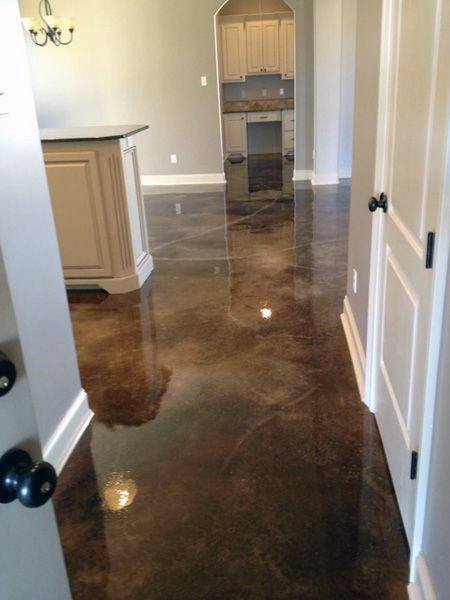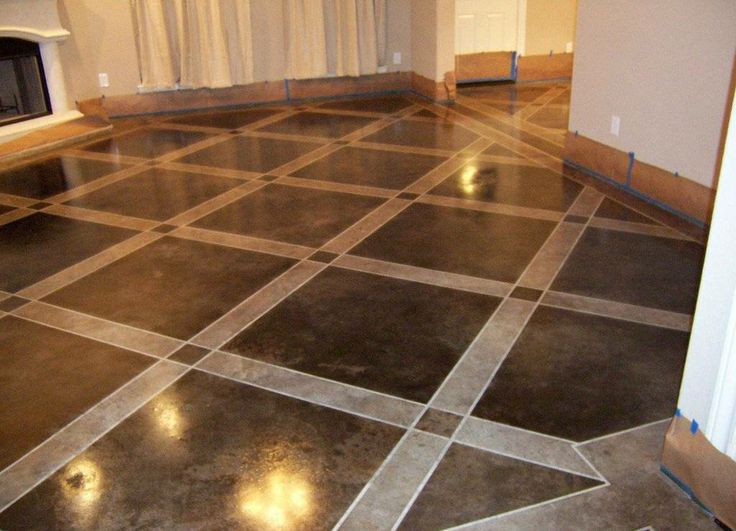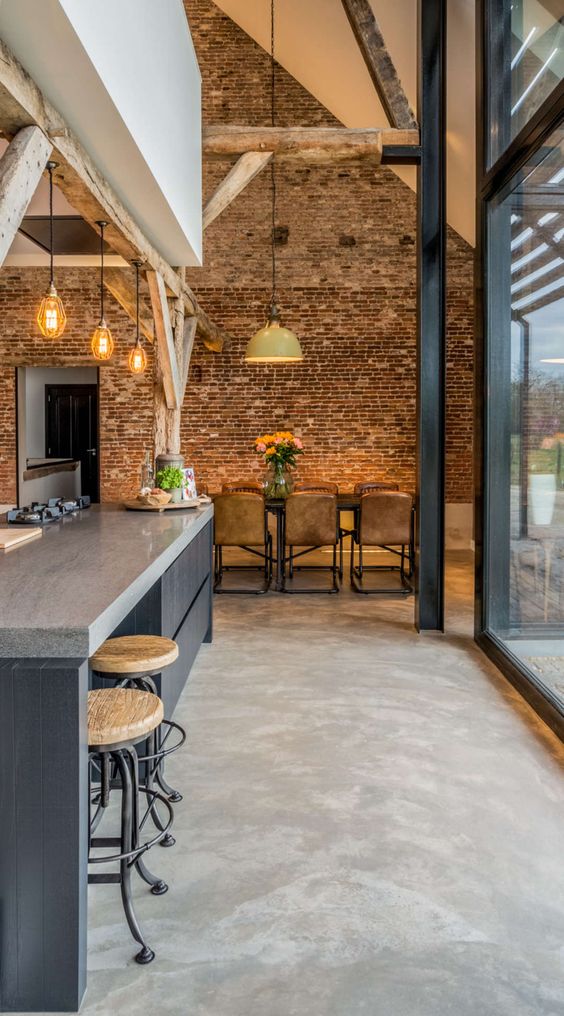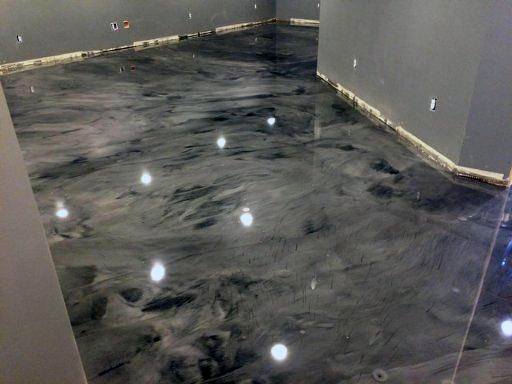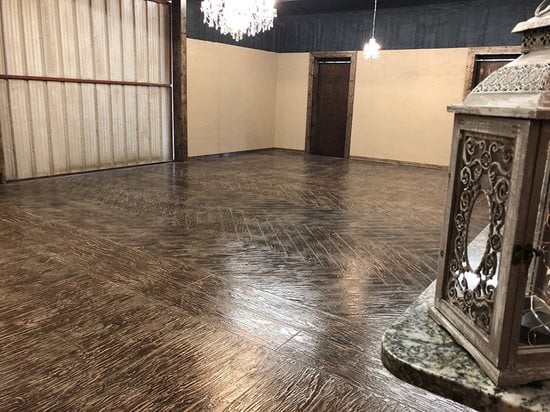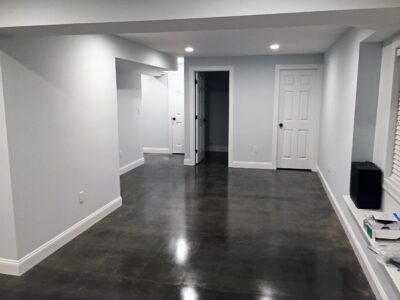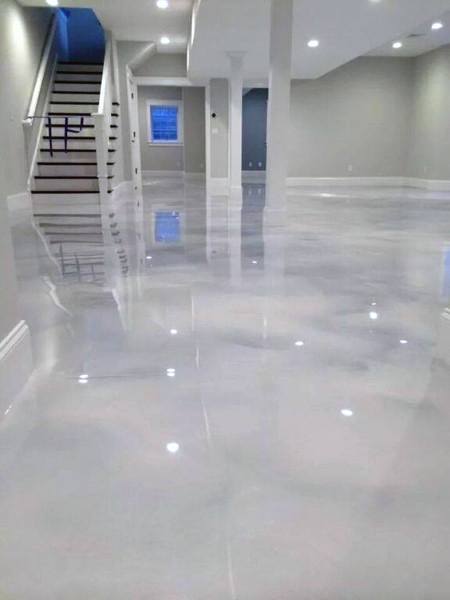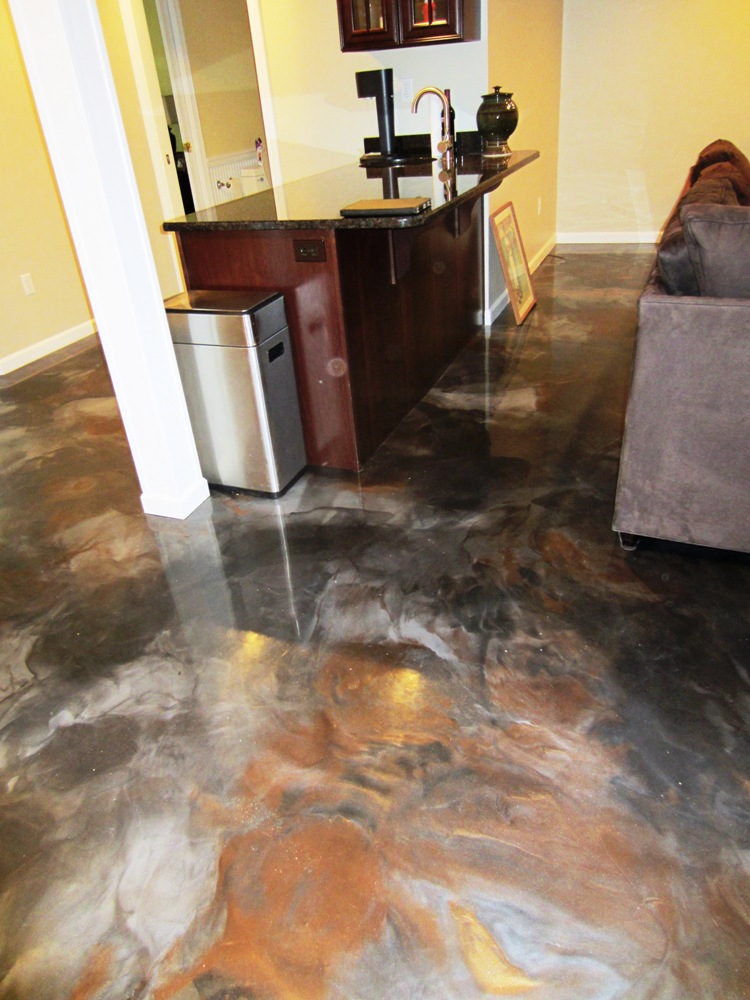Introduction to Decorative Concrete Floors
Decorative concrete floors have emerged as a popular choice for homeowners and designers seeking a versatile and stylish flooring option. Unlike traditional concrete floors, which are often considered utilitarian and plain, decorative concrete offers a wide range of design possibilities, allowing you to customize your floors to suit your aesthetic preferences and design vision. From polished concrete to stamped patterns and colorful stains, decorative concrete floors can transform any space into a stunning and unique environment. Let’s discuss the versatility and benefits of decorative concrete floors as a flooring option.
- Customizable Designs: One of the key advantages of decorative concrete floors is their customizable nature. With various techniques such as staining, stamping, and scoring, you can achieve virtually any design or pattern imaginable, from intricate tile patterns to faux wood finishes. Decorative concrete allows you to create a truly unique and personalized flooring design that reflects your style and complements your space.
- Durability and Longevity: Decorative concrete floors are highly durable and long-lasting, making them an ideal choice for high-traffic areas such as kitchens, living rooms, and entryways. Unlike traditional flooring materials like hardwood or carpet, decorative concrete resists scratches, stains, and moisture, ensuring that your floors maintain their beauty and integrity for years to come. With proper maintenance, decorative concrete floors can withstand the rigors of daily use while retaining their aesthetic appeal.
- Versatility in Applications: Decorative concrete floors are suitable for a wide range of applications, from residential to commercial settings. Whether you’re renovating your home, upgrading your outdoor patio, or designing a retail space, decorative concrete offers versatility and flexibility in design and functionality. It can be used indoors or outdoors, on floors, countertops, or even walls, allowing you to create a cohesive and stylish look throughout your space.
- Cost-Effective Solution: Compared to other flooring options such as hardwood, tile, or natural stone, decorative concrete is often more cost-effective in terms of materials and installation. While the initial cost of decorative concrete may vary depending on the design complexity and installation method, its long-term durability and minimal maintenance requirements can result in significant cost savings over time. Additionally, decorative concrete can mimic the look of more expensive materials, providing a budget-friendly alternative without compromising on style or quality.
- Eco-Friendly Choice: Decorative concrete floors are considered an eco-friendly flooring option due to their minimal environmental impact and energy efficiency. Concrete is a sustainable material that can be recycled and repurposed, reducing waste and conserving natural resources. Additionally, decorative concrete floors can be polished to a high sheen, maximizing natural light and reducing the need for artificial lighting, which contributes to energy savings and lower utility costs.

Creative Applications of Decorative Concrete Floors
Decorative concrete floors offer endless design possibilities, allowing you to unleash your creativity and imagination to create stunning and unique flooring designs. From sleek and modern to rustic and industrial, decorative concrete can be customized to suit any design style and aesthetic preference. Whether you’re looking to add a touch of elegance to your home or make a bold statement in a commercial space, here are some creative applications of decorative concrete floors to inspire your next project:
Polished Concrete Floors:
Sleek and Modern: Polished concrete floors are a popular choice for modern and minimalist interiors. With their smooth and glossy finish, polished concrete floors create a sleek and contemporary look that enhances the overall aesthetic of any space. They are ideal for open-concept living areas, kitchens, and commercial spaces, adding a touch of sophistication and style.
Reflective Surfaces: Polished concrete floors have a reflective surface that amplifies natural light, making them an excellent choice for spaces with limited natural light. The high sheen of polished concrete creates a bright and airy atmosphere, making rooms feel more spacious and inviting.
Stamped Concrete Patterns:
Mimicking Natural Materials: Stamped concrete allows you to mimic the look of natural materials such as stone, brick, or wood, without the maintenance requirements and costs associated with traditional materials. Stamped concrete patterns can be customized to replicate various textures and patterns, from rustic cobblestone to intricate tile designs.
Outdoor Living Spaces: Stamped concrete is an excellent choice for outdoor living spaces such as patios, pool decks, and walkways. With its durability and versatility, stamped concrete can withstand outdoor elements while adding style and functionality to your outdoor areas.
Colored Concrete Stains:
Vibrant Color Palette: Colored concrete stains offer a wide range of vibrant colors and shades to choose from, allowing you to add a pop of color to your floors. Whether you prefer bold and bright hues or subtle and understated tones, colored concrete stains can be customized to suit your design preferences.
Artistic Expression: Colored concrete stains provide a creative outlet for artistic expression, allowing you to create custom patterns, designs, and motifs on your floors. From abstract geometric shapes to intricate floral patterns, the possibilities are endless with colored concrete stains.
Textured Concrete Finishes:
Rustic and Industrial Vibes: Textured concrete finishes, such as trowel finishes or exposed aggregate, add a rustic and industrial charm to any space. With their rough and tactile surfaces, textured concrete finishes create visual interest and depth, adding character and personality to your floors.
Non-Slip Surfaces: Textured concrete finishes are ideal for areas that require slip resistance, such as bathrooms, kitchens, and outdoor walkways. The textured surface provides traction and grip, reducing the risk of slips and falls, especially in wet or high-traffic areas.
Customized Inlays and Borders:
Personalized Touch: Customized inlays and borders allow you to add a personalized touch to your decorative concrete floors. Whether you want to incorporate your initials, logo, or a decorative motif, inlays and borders can be customized to reflect your unique style and personality.
Elevated Design Elements: Inlays and borders can elevate the design of your decorative concrete floors, adding visual interest and defining different zones within a space. Whether used as a focal point in a room or as a subtle accent, customized inlays and borders enhance the overall aesthetic appeal of your floors.
Pros and Cons of Decorative Concrete Flooring
Decorative concrete flooring has gained popularity for its versatility and aesthetic appeal, but it’s essential to weigh the practical considerations before making a decision. Here are some pros and cons to consider:
Pros:
Durability: Decorative concrete flooring is highly durable and long-lasting, able to withstand heavy foot traffic, spills, and wear and tear. Properly sealed decorative concrete floors can last for decades without significant signs of wear.
Versatility: With decorative concrete, the design possibilities are virtually limitless. From stamped patterns and stained colors to polished finishes and custom designs, decorative concrete can be tailored to fit any design aesthetic.
Low Maintenance: Compared to other flooring options, decorative concrete requires minimal maintenance. Regular sweeping and occasional mopping with a neutral cleaner are typically all that’s needed to keep decorative concrete floors looking their best.
Cost-Effective: In many cases, decorative concrete can be a cost-effective flooring option compared to materials like hardwood, tile, or natural stone. The overall cost will depend on factors such as the complexity of the design, surface preparation, and sealing requirements.
Cons:
Installation Complexity: Achieving desired decorative concrete effects may require skilled professionals and specialized equipment. Improper installation can lead to issues such as uneven color distribution, surface imperfections, or premature wear.
Moisture Sensitivity: Unsealed decorative concrete is porous and susceptible to moisture absorption, which can lead to staining, mold growth, or even structural damage in extreme cases. Proper sealing is essential to mitigate these risks, especially in humid environments or areas prone to water exposure.
Initial Investment: While decorative concrete can be cost-effective in the long run, the initial investment may be higher compared to basic concrete or other flooring materials. Additional expenses may include surface preparation, staining or stamping techniques, and professional installation.
Limited Insulation: Concrete, including decorative varieties, tends to have poor insulation properties, meaning it can feel cold underfoot in colder climates. Area rugs or underfloor heating systems can help mitigate this issue, but it’s something to consider when choosing decorative concrete for residential spaces.
Susceptibility to Damage: While durable, decorative concrete is not impervious to damage. Heavy impact from dropped objects, abrasive cleaning methods, or exposure to harsh chemicals can cause scratches, chips, or discoloration, requiring repairs or refinishing.
Maintaining Tips
Decorative concrete floors are a stylish and durable flooring option that can enhance the aesthetic appeal of any space. Whether you have stamped patterns, stained colors, or polished finishes, proper cleaning and maintenance are essential to preserve the elegance and longevity of decorative concrete floors. Below are some tips for cleaning and caring for decorative concrete floors to keep them looking their best for years to come.
Regular Cleaning Routine:
Sweep or Vacuum: Regularly sweep or vacuum your decorative concrete floors to remove dust, dirt, and debris that can scratch the surface. Use a soft-bristled broom or vacuum with a brush attachment to avoid scratching the surface of the concrete.
Damp Mop with Gentle Cleaner: Use a damp mop with a mild detergent or pH-neutral cleaner to clean decorative concrete floors. Avoid using harsh chemicals or abrasive cleaners, as they can damage the finish and integrity of the concrete. Rinse the mop frequently and change the cleaning solution as needed to prevent streaks and residue buildup.
Preventing Stains and Spills:
Wipe Up Spills Immediately: Accidental spills should be wiped up immediately to prevent staining and damage to decorative concrete floors. Use a clean, damp cloth to blot up spills, and avoid rubbing or scrubbing the surface, as this can spread the stain and cause further damage.
Use Mats and Rugs: Place mats or rugs in high-traffic areas and entryways to protect decorative concrete floors from scratches, scuffs, and wear. Mats can also help trap dirt and debris, preventing them from being tracked onto the surface of the concrete.
Avoid Harsh Chemicals:
Use Gentle Cleaning Products: Avoid using harsh chemicals, acidic cleaners, or abrasive scrubbers on decorative concrete floors, as they can damage the finish and integrity of the concrete. Stick to mild detergents or pH-neutral cleaners designed specifically for use on concrete surfaces.
Test New Products: Before using a new cleaning product or solution on decorative concrete floors, test it in an inconspicuous area to ensure compatibility and prevent damage. Allow the test area to dry completely before evaluating the results and proceeding with cleaning the rest of the floor.
Reapply Sealant as Needed:
Regular Maintenance: Decorative concrete floors should be sealed regularly to protect the surface and enhance its longevity. Follow the manufacturer’s recommendations for reapplying sealant, typically every 1-3 years depending on the level of foot traffic and wear.
Professional Maintenance: Consider scheduling professional cleaning and maintenance for your decorative concrete floors to ensure they remain in optimal condition. Professional cleaners have the expertise and tools to deep clean and restore the beauty of decorative concrete floors without causing damage.
Preventative Measures:
Use Protective Pads: Place felt pads or furniture protectors under heavy furniture to prevent scratches and dents on decorative concrete floors. Lift furniture when moving it across the floor to avoid dragging and scratching the surface.
Trim Pet Nails: Keep your pet’s nails trimmed to minimize scratches and damage to decorative concrete floors. Encourage pets to use designated areas for scratching and grooming to prevent damage to the surface of the concrete.
Other Stylish Flooring Options for Various Settings
While decorative concrete floors offer a versatile and stylish flooring option for many spaces, there are several alternative flooring options to consider based on your design preferences and specific needs. From hardwood and tile to laminate and vinyl, exploring alternatives to decorative concrete allows you to customize your space and achieve the desired look and functionality. Below are some other stylish flooring options for various settings to help you make an informed decision for your home or project.
Hardwood Flooring:
Timeless Elegance: Hardwood flooring offers timeless elegance and natural beauty that adds warmth and sophistication to any space. With a wide range of wood species, finishes, and textures to choose from, hardwood flooring can be customized to suit any design style or aesthetic preference.
Durability: High-quality hardwood flooring is durable and long-lasting, able to withstand the rigors of daily use and maintain its beauty and integrity for years to come. Hardwood floors can be sanded and refinished multiple times, allowing them to look new even after years of use.
Versatility: Hardwood flooring is versatile and can be installed in various settings, including living rooms, bedrooms, and dining areas. It complements a wide range of design styles, from traditional to contemporary, making it a popular choice for homeowners and designers alike.
Warmth and Comfort: Hardwood flooring adds warmth and comfort to any space, providing a cozy and inviting atmosphere. Unlike colder flooring options such as tile or concrete, hardwood floors feel warmer underfoot and help maintain a comfortable indoor temperature.
Tile Flooring:
Variety of Options: Tile flooring comes in a variety of materials, including ceramic, porcelain, and natural stone, offering endless design possibilities for any space. From classic subway tiles to intricate mosaic patterns, tile flooring allows homeowners and designers to create custom looks that suit their design preferences.
Durability: Tile flooring is highly durable and resistant to scratches, stains, and moisture, making it ideal for high-traffic areas such as kitchens, bathrooms, and entryways. With proper installation and maintenance, tile flooring can withstand the test of time and maintain its beauty and functionality for years to come.
Easy Maintenance: Tile flooring is relatively easy to clean and maintain, requiring regular sweeping or vacuuming and occasional mopping with a mild detergent. Grout lines should be sealed periodically to prevent staining and water damage, ensuring that tile flooring remains in optimal condition.
Laminate Flooring:
Affordability: Laminate flooring is an affordable alternative to hardwood and tile, offering the look and feel of natural materials at a fraction of the cost. It is available in a wide range of styles, colors, and textures, allowing homeowners to achieve the desired look for their space without breaking the bank.
Durability: Laminate flooring is highly durable and resistant to scratches, stains, and moisture, making it suitable for high-traffic areas such as living rooms, dining rooms, and hallways. It is also resistant to fading from sunlight exposure, ensuring that laminate flooring maintains its beauty and integrity over time.
Easy Installation: Laminate flooring is easy to install and can be installed over existing flooring materials, reducing the need for extensive subfloor preparation. It is available in various installation options, including glue-down, click-lock, and floating, making it a convenient choice for DIY enthusiasts.
Vinyl Flooring:
Waterproof: Vinyl flooring is waterproof and highly resistant to moisture, making it ideal for bathrooms, kitchens, and other high-moisture areas. It is available in a wide range of styles, including luxury vinyl plank and tile, that mimic the look and feel of natural materials such as hardwood and stone.
Durability: Vinyl flooring is highly durable and resistant to scratches, stains, and dents, making it suitable for high-traffic areas such as entryways, mudrooms, and family rooms. It is also easy to clean and maintain, requiring regular sweeping or vacuuming and occasional mopping with a mild detergent.
Affordability: Vinyl flooring is an affordable option for homeowners and designers seeking a stylish and durable flooring solution. It is typically less expensive than hardwood, tile, or laminate flooring, making it a budget-friendly choice for any space.
Carpet Flooring:
Comfort and Softness: Carpet flooring adds comfort and softness to any space, providing a cozy and inviting atmosphere. It is available in a wide range of colors, patterns, and textures, allowing homeowners to customize the look and feel of their space.
Insulation: Carpet flooring provides insulation against cold temperatures and noise, making it ideal for bedrooms, living rooms, and other areas where comfort and quiet are desired. It helps maintain a comfortable indoor temperature and reduces energy costs by retaining heat in the winter months.
Versatility: Carpet flooring is versatile and can be installed in various settings, including bedrooms, living rooms, and basements. It complements a wide range of design styles, from traditional to contemporary, making it a popular choice for homeowners and designers alike.
Painted Concrete Floors, Concrete Floor Paint
Concrete Flooring Ideas With Pros And Cons
Best Concrete Floor Ideas – Smooth Flooring Interior Designs
Concrete Floor Covering Options & Ideas
Basement Floor Staining Ideas Direct Colors
An In-Depth Look at 30 Concrete Floor Designs – Concrete Flooring
Pin on concrete floor ideas
The Pros of Concrete Flooring American Concrete Polishing
Best Concrete Floor Ideas – Smooth Flooring Interior Designs
Polished Concrete the Perfect Floor Covering?
Related Posts:
- Applying Concrete Floor Paint
- Non Slip Concrete Floor Sealer
- How To Paint Concrete Garage Floor
- Outdoor Concrete Floor Ideas
- Concrete Floor Covering Ideas
- Cracks In Polished Concrete Floors
- Drylok Concrete Floor Paint Colors
- Polished Concrete Floor Thickness
- Residential Stained Concrete Floors
- Cheap Concrete Floor Finishes

